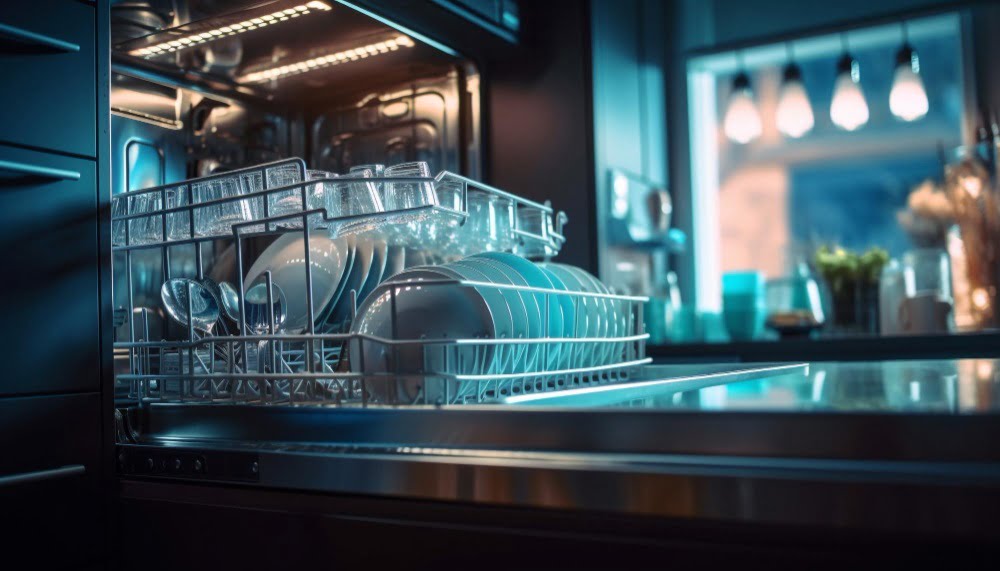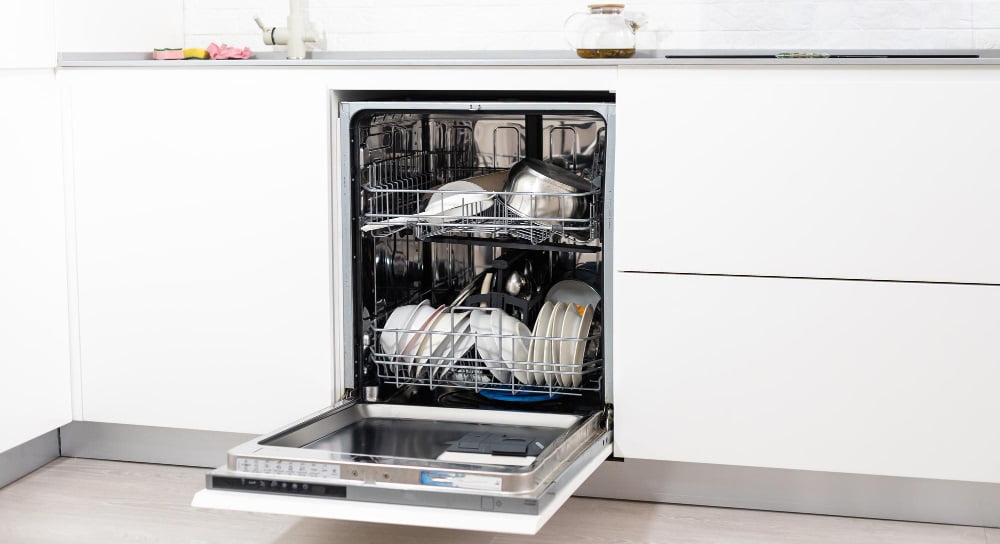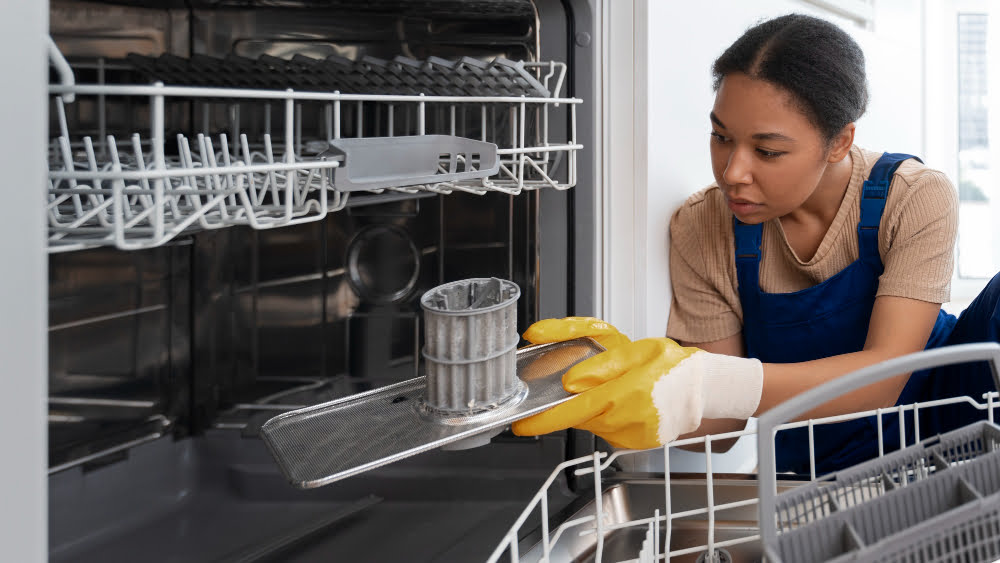
A dishwasher is a kitchen appliance for washing dishes automatically. You load dirty dishes into it, and it cleans them for you. It sprays warm water mixed with dishwasher detergent onto the dishes to remove food and stains.
Dishwashers come with different settings. There are strong cycles for very dirty items, gentle cycles for delicate dishes, and eco-friendly options to save water and energy. Many models also dry the dishes after washing.
It uses less water and cleans dishes more effectively, thanks to the high temperatures it can reach.
Dishwashers vary in size and style. There are large ones that fit under counters and small ones for countertops. Smart dishwashers can be controlled via smartphone.
In short, a dishwasher is a practical appliance that saves time and effort in dish cleaning.
For any kind of dishwasher repair in British Columbia you can contact us.
Dishwashers are useful in our homes. They do more than clean dishes; they make life easier and save time.
With a dishwasher, you don't have to spend ages washing dishes by hand. This is great for busy families or anyone with a lot to do. It means more time for yourself or with your family.
Dishwashers also help keep your kitchen germ-free. They wash dishes with hot water, which removes germs more than hand washing. This is especially good for keeping everyone healthy.
These machines are good for the environment, too. They use less water and power than washing by hand, which can also help cut down your bills.
A neat kitchen is another plus. Dishwashers keep dirty dishes out of sight, making your kitchen a nicer, cleaner space.
Most dishwashers today have different settings for all sorts of dishes, from fragile glasses to big pots. They make sure everything gets clean and is ready to use.
This blog is your comprehensive guide to dishwashers. We've got you covered, from understanding how they work to choosing the right type for your needs.


Getting to know your dishwasher is key to using it well. Let's break down what's inside it and how it cleans your dishes:
Dishwashers today are not just about cleaning dishes; they come equipped with a variety of settings to cater to different washing needs. To make the most of your dishwasher, it's essential to understand these settings and how they can optimize your dishwashing experience. Let's delve into the various settings found on most dishwashers and what they mean for your dish-cleaning routine:
Normal Setting
This is the standard go-to setting for everyday dishwashing. It's designed to handle a full load of dishes with a moderate level of dirtiness, providing a balance between efficiency and thorough cleaning.
Heavy-Duty Setting
When dealing with pots, pans, and other cookware that has accumulated tough, baked-on food, the heavy-duty setting is your best bet. It uses more water and a longer wash cycle to tackle hard-to-clean items effectively.
Eco-Friendly Setting
The eco-friendly setting is ideal for those conscious about their water and energy usage. It conserves water and energy by using lower temperatures and a longer washing duration to achieve cleanliness without waste.
Quick Wash Setting
Perfect for lightly soiled dishes or when you're in a hurry, the quick wash setting cleans dishes in a shorter time frame. It's ideal for freshening up a few items or a small load when you need them quickly.
Glass or Delicate Setting
This setting is tailored for delicate glassware and fragile dishes. It uses a gentler wash and lower temperatures to clean without causing damage to your sensitive items.
Sanitize Setting
Essential for families or during illness, the sanitize setting uses high temperatures to kill bacteria and germs, ensuring your dishes are clean and hygienic.
Rinse Only Setting
This setting is ideal if your dishes are only lightly used or you want to give them a quick rinse before a full wash later. It rinses away food residues and odours without using detergent.
Auto or Smart Setting
Utilizing advanced sensors, the auto setting adjusts the cycle time, water temperature, and intensity based on how dirty the dishes are. This smart feature ensures optimal cleaning with maximum efficiency.
By understanding these settings, you can tailor your dishwashing process to suit various types of loads and levels of soiling. This ensures your dishes come out sparkling clean and helps conserve energy and water, aligning with environmentally friendly practices. With this knowledge, you can now confidently navigate the settings on your dishwasher, making it a more effective and efficient tool in your daily kitchen routine.

Getting your dishwasher up and running for the first time is straightforward with these steps:
Initial Setup
Ensure your dishwasher is installed correctly. Remove any inside packaging and familiarize yourself with the control panel. Don't forget to glance through the user manual for specific instructions.
Loading Tips
Proper loading is key for clean dishes. Place larger, dirtier items on the bottom rack and lighter, delicate ones on top, ensuring they don't block each other for effective cleaning.
Using Detergent
Choose a suitable dishwasher detergent and follow the recommended amount. Avoid overusing to prevent soap residue on dishes.
Selecting the Wash Cycle
Match the cycle to your dish load. Use 'normal' for everyday dishes and a more intense setting for heavily soiled items.
Water Temperature Check
For optimal performance, your dishwasher water should be around 120°F. This ensures effective cleaning.
Starting Your Dishwasher
Load the dishes, add detergent, close the door, select the cycle, and start. If available, use the delay start feature to schedule your wash.
Monitoring the First Wash
Keep an eye on the dishwasher during the first cycle to ensure everything is working as it should.
Unloading Process
Once the cycle ends and the dishes are cool, start unloading from the bottom rack to prevent water from top dishes from dripping onto them.
Post-Use Maintenance
After unloading, clear any leftover food particles from the filters. Leave the door slightly open to air dry the interior.
Regular Cleaning
Maintain your dishwasher by regularly cleaning key components like spray arms and filters. Run a dishwasher cleaner or a vinegar cycle occasionally for thorough cleaning.
By following these easy steps, you'll ensure your dishwasher operates smoothly from the very start, making your dishwashing experience efficient and trouble-free.
Dishwashers have evolved into an essential appliance in modern kitchens, offering a range of types to suit different needs and spaces. Understanding the variety available can help you make an informed choice for your home. Here's a closer look at the diverse types of dishwashers:
Each type of dishwasher offers unique features and benefits, catering to different lifestyles and kitchen designs. Whether you prioritize space-saving solutions or seek a high-capacity machine for a large family, there's a dishwasher type to meet your specific needs.
Consider replacing your dishwasher if it's over a decade old, not energy-efficient, or not meeting your needs. Here'e a few modern features that might align with your dishwasher needs. Therefore, decide wisely between upgrading and replacing one.
We've explored dishwasher benefits, workings, types, and maintenance, providing a thorough understanding of this valuable appliance.
Therefore, by now, we know how a well-maintained dishwasher saves time and energy and ensures hygienic cleaning of your dishes.
Furthermore, Consider the information provided to make an informed decision about upgrading or maintaining your dishwasher in 2024 and enjoy the convenience & efficiency it brings to your daily life.